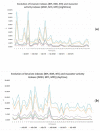Ecological Momentary Assessment of Masseter Muscle Activity in Patients with Bruxism
- PMID: 36612902
- PMCID: PMC9819829
- DOI: 10.3390/ijerph20010581
Ecological Momentary Assessment of Masseter Muscle Activity in Patients with Bruxism
Abstract
According to the International Bruxism Consensus, bruxism refers to the activity of the masticatory muscles reflecting contraction disorders, regardless of whether it is during sleep (SB) or an awake (AB) state. The objective of the present study was to evaluate the activity of the masseter muscle by surface electromyographic (sEMG) recordings. This study was performed on 20 participants with self-reported “possible bruxism” (study group) and 20 participants with no self-reported bruxism (control group); all participants underwent an evaluation of the masseter muscle activity using the dia-BRUXO device, which provides numerical parameters regarding sEMG (the total duration and the type of bruxism specific events, the effort made by the masticatory muscles during the recording period, and the personal bruxism index of each participant). Participants from the study group presented more clenching events during AB, three times more frequent than the control group (p = 0.002, Mann−Whitney U test); for SB, the frequency of clenching and grinding events was comparable within the study group, being more frequent than for the control group; the mean value of the effort index was higher for AB (1.177%) than SB (0.470%) and the same for the duration index, with a mean value of 2.788% for AB and 1.054% for SB. All participants from the control group presented reduced values for all acquired parameters. Overall, the personal bruxism index in AB was approximately four times higher for the study group (2.251%) compared to the control group (0.585%) (p < 0.005, Mann−Whitney U test). Similar values were obtained for SB. All participants with “possible bruxism” from the study group presented a higher activity of the masseter muscle, which is specific for bruxism, thus being defined as “definite bruxism”.
Keywords: EMG; bruxism; clenching; grinding; masseter muscle; muscular contractions.
Conflict of interest statement
The authors declare no conflict of interest.
Figures






Similar articles
-
Assessment of awake bruxism-Combinational analysis of ecological momentary assessment and electromyography.J Prosthodont Res. 2024 Jan 16;68(1):166-171. doi: 10.2186/jpr.JPR_D_22_00289. Epub 2023 Jun 7. J Prosthodont Res. 2024. PMID: 37286504
-
Effects of botulinum toxin on jaw motor events during sleep in sleep bruxism patients: a polysomnographic evaluation.J Clin Sleep Med. 2014 Mar 15;10(3):291-8. doi: 10.5664/jcsm.3532. J Clin Sleep Med. 2014. PMID: 24634627 Free PMC article. Clinical Trial.
-
Effect of occlusal splints on the EMG activity of masseter and temporal muscles in bruxism with clinical symptoms.J Oral Rehabil. 1982 Mar;9(2):119-23. doi: 10.1111/j.1365-2842.1982.tb00541.x. J Oral Rehabil. 1982. PMID: 6951020
-
Masseter EMG activity during sleep and sleep bruxism.Arch Ital Biol. 2011 Nov 7;149(4):478-91. doi: 10.4449/aib.v149i4.1317. Arch Ital Biol. 2011. PMID: 22205593 Review.
-
Signal acquisition and analysis of ambulatory electromyographic recordings for the assessment of sleep bruxism: A scoping review.J Oral Rehabil. 2021 Jul;48(7):846-871. doi: 10.1111/joor.13170. Epub 2021 May 2. J Oral Rehabil. 2021. PMID: 33772835 Free PMC article.
Cited by
-
Aspects of Dental Occlusion Assessed with the T-Scan System among a Group of Romanian Dental Students in a Cross-Sectional Study.Int J Environ Res Public Health. 2023 Mar 10;20(6):4877. doi: 10.3390/ijerph20064877. Int J Environ Res Public Health. 2023. PMID: 36981784 Free PMC article.
-
Neuromuscular and occlusion analysis to evaluate the efficacy of three splints on patients with bruxism.BMC Oral Health. 2023 May 25;23(1):325. doi: 10.1186/s12903-023-03044-5. BMC Oral Health. 2023. PMID: 37231466 Free PMC article.
-
Non-Instrumental and Instrumental Tools Validity in Bruxism Diagnostics.Diagnostics (Basel). 2025 Jan 16;15(2):200. doi: 10.3390/diagnostics15020200. Diagnostics (Basel). 2025. PMID: 39857084 Free PMC article.
-
Study Regarding the Monitoring of Nocturnal Bruxism in Children and Adolescents Using Bruxoff Device.Diagnostics (Basel). 2023 Oct 17;13(20):3233. doi: 10.3390/diagnostics13203233. Diagnostics (Basel). 2023. PMID: 37892054 Free PMC article.
-
Patients' Satisfaction after the Treatment of Moderate Sleep Apnea and Nocturnal Bruxism with Botox or/and Thermoformed Occlusal Splints: A Pilot Study.J Pers Med. 2024 Sep 26;14(10):1029. doi: 10.3390/jpm14101029. J Pers Med. 2024. PMID: 39452536 Free PMC article.
References
-
- Frohman B.S. Application of psychotherapy to dental problems. Dent. Cosmet. 1931;73:1117–1122.
-
- De Leeuw R., Klasser G.D., editors. Orofacial Pain. Guidelines for Assessment, Diagnosis, and Management. 4th ed. Quintessence Publishing Co, Inc.; Chicago, IL, USA: 2008. p. 316.
-
- American Academy of Sleep Medicine . International Classification of Sleep Disorders. 2nd ed. American Academy of Sleep Medicine; Westchester, NY, USA: 2005.
Publication types
MeSH terms
LinkOut - more resources
Full Text Sources

